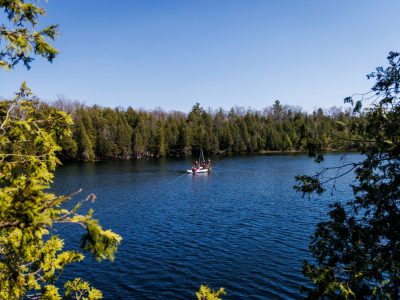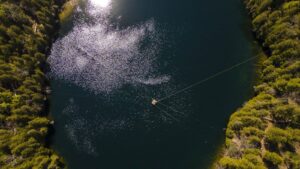
Science Says What? is a monthly column written by Great Lakes now contributor Sharon Oosthoek exploring what science can tell us about what’s happening beneath and above the waves of our beloved Great Lakes and their watershed.
A tiny lake just an hour’s drive from Toronto made headlines earlier this summer as the best place in the world to illustrate the dawn of a new geological epoch – the Anthropocene.
Scientists have spent the past 14 years debating a proposal for the Anthropocene to recognize the profound changes humans have wrought on Earth’s geology and ecosystems. If the geological community accepts the proposal later this year, the muddy sediments of Crawford Lake will be its model example.
As a science journalist, I’ve written extensively about climate change, microplastic pollution, dirty air and oil spills. I understand the impact we humans have had on the Earth.
But that this pretty little lake my sons toddled around as youngsters should hold such significance has taken me aback. Knowing the place we watched sunfish build and guard their nests is considered ground zero for the indelible mark our species has left on the planet is … well, more unsettling than I expected.
Parents – sunfish included – are supposed to protect their young. Yet I know I can’t protect my boys from a warming climate, from chemical-leaching plastic pollution, or from any number of environmental assaults on our planet.
It’s sedimentary, my dear
I get why the Anthropocene Working Group chose Crawford Lake. It has a surface area of just 2.4 hectares – you can walk around it in 15 minutes – but it’s 24 metres deep. This ratio means it has two distinct layers of water which never mix, making it a meromictic lake.
For centuries, airborne particles have landed on the lake’s surface and drifted down, forming layer after layer of sediment. Each year’s worth of particles is clearly separated by a distinctive white line of calcium carbonate that leaches from the water over the summer.
Because the bottom is deep, cold and undisturbed, Crawford Lake’s sediments give a precise annual accounting of environmental conditions over the years.
The argument for the Anthropocene comes from the layers from 1952 onward. Radioactive plutonium from atmospheric nuclear bomb detonations starting around 1945 and peaking in the early 1950s can be clearly seen in the sediment.
That plutonium settled all over the planet around this time, which is why researchers are proposing 1952 mark the start of this new geological epoch.

An aerial view of the platform in Crawford Lake that researchers use to collect sediment from the bottom. (Courtesy of Brock University)
Longing for a pristine past
But if you dial back the clock to the 13th century, the layers tell a different story. It’s a story about a lakeside First Nations village where hundreds of Iroquoian-speaking people once lived
Pollen from their three sisters’ gardens of maize, bean and squash is part of Crawford’s sedimentary record. In fact, it was the clue that first tweaked then University of Toronto master’s botany student Maria Boyko to the village’s historic presence.
Shortly after her discovery, excavations in the 1970s and 80s uncovered the footprint of 11 longhouses, as well as more than 10,000 artifacts from the day-to-day lives of the those who lived there.
The local First Nation and the conservation authority that manages the area recreated the village, featuring three reconstructed longhouses and a three sisters’ garden. I have great memories of my boys watching the fire-starting demonstrations in one of the longhouses, and trying out the technique back home in our driveway.
Thinking about this, I can’t help but long for a time when humanity lived in harmony with nature, as those villagers probably did.
Whether or not such a time ever existed, I recognize this longing for a pristine past can be dangerous. We can get stuck in idealizing the “good old days” and feel despondent because we can’t turn back time.
While the concept of the Anthropocene is grounded in science, the act of declaring it raises profound reflections about our place in the world – about our responsibility, guilt and the future of our planet.
What the scientist says
Because I was kinda freaked out that so much existential weight should be riding on ‘my’ little lake, I wanted to bounce my anxiety off the scientist who knows Crawford best. I phoned Brock University micropaleontologist Francine McCarthy, who has been studying its sediments for 20 years and is a member of the Anthropocene Working Group.
“Yeah, it’s hard even for us to get our heads around,” she told me. “It’s not awe-inspiring. It’s just a pretty little lake that happens to hold the best record of the damage we’ve done.
“I can think of only one other species that has affected the planet more – the cyanobacteria who back two billion years ago oxygenated the atmosphere. The cyanobacteria didn’t have the ability to think it through, recognise what they were doing and consider the consequences. But we do.”
This act of knowing is powerful, McCarthy told me. It means we can learn from our mistakes. It means we can do better.
Like many of us, McCarthy understands the magnitude of the work involved in restoring the Earth to some kind of workable balance – for us and for other creatures – challenges us to maintain hope.
So like a child waking from a nightmare and wanting her mom to convince her everything will be fine, I asked how she could be optimistic. She pointed to changes in the sedimentary record between the 1950s and 60s and the present.
Starting in the 50s, McCarthy said, Crawford Lake’s sediments provide a record of belching smokestacks and untreated effluent. But by the 1980s, it shows a drastic reduction.
That’s right around the time activists such as Rachel Carson – author of Silent Spring –started spurring us to clean up our act, waking up an entire generation to the environmental impact of its actions.
“None of the pollution was curbed in the 50s and 60s, but engineers came up with ways to scrub smokestacks and treat effluent. Now the sedimentary record looks much better because of those checks and balances,” she said.
“So you’re hopeful then?” I asked, hopefully.
“Well, we can’t be Peter Pan about it,” she said. “There’s a limit to engineering fixes and the real problem is the population. We can’t go back to the 13th century. There are 8 billion of us now.”
Catch more news at Great Lakes Now:
Science Says What? Bacteria in Lake Huron sinkhole do a daily tango
Science Says What? Looking for love as northern forests heat up
Featured image: Crawford Lake is deep, sheltered and undisturbed, making it an ideal location to see evidence of the proposed Anthropocene in its sediments. (Courtesy of Brock University)
10 Comments
-
Would you please change the word Iroqouis to Anishinabek? Iroquois is a derogatory French word that the Anishanabee no longer use. I ask in the spirit of Truth and Reconciliation to properly identify the language group with the current and correct name.
-
I’m afraid I don’t agree that population is killing the earth. True, the actions of some of the 8 billion are causing harm, but I believe that if we mend our ways, take corrective action, and give the situation time for corrective actions to have effect, we can see a healthy earth supporting way more people than now.
Not that a larger number of people is desirable. Neither is a smaller number of people, by itself. My only point is, the earth has neither exceeded nor even reached its human capacity.
-
Great article. Very informative. Let’s hope it’s accepted as a study region. Should be also studied and followed by our students. Terrific educational value.
-
Great article and pictures are very beautiful I made up my mind to visit
I am from India and very much love lake and scence
Thanks -
Very informative article. We can be proud of Crawford Lake having been chosen as the spot where such important research is being conducted.
Since not said in the article, I can add further background info. Crawford Lake didn’t exist prior to the end of the last Ice Age. It owes its existence to the fact that starting around 11,000 years ago, glacial meltwater began flowing south along the edge of the Niagara Escarpment, from the southern slope of the Oak Ridges Moraine towards glacial Lake Iroquois. It was the strength of the meltwater’s flow at that particular spot which carved Crawford Lake out from the underlying bedrock.
It was only after the southward flow of glacial meltwater abated that Crawford became a distinct, land-locked lake – one in which the historical record could then begin to be laid down in the layers of sediments thereafter deposited as described in the article.
Lee Kovalskyj,
Toronto -
Awesome article but I respectfully disagree with the last paragraph about population being the problem; we are at the forefront of being able to live sustainably.
-
I came here as a child and enjoyed this article. I live in Hamilton, GO CRAWFORD LAKE!!!
-
One of the best articles, I have ever read.
All 8 billion of us should read it and understand, the difference we can all make.
Great effort!!!!
It’s about time ,we all should chip in to keep our race healthy and alive. -
Author
Thanks Steve. What do you teach?
-
I agree with Steve G. Great article. Clear, easy to understand, and specific. Thank you!

